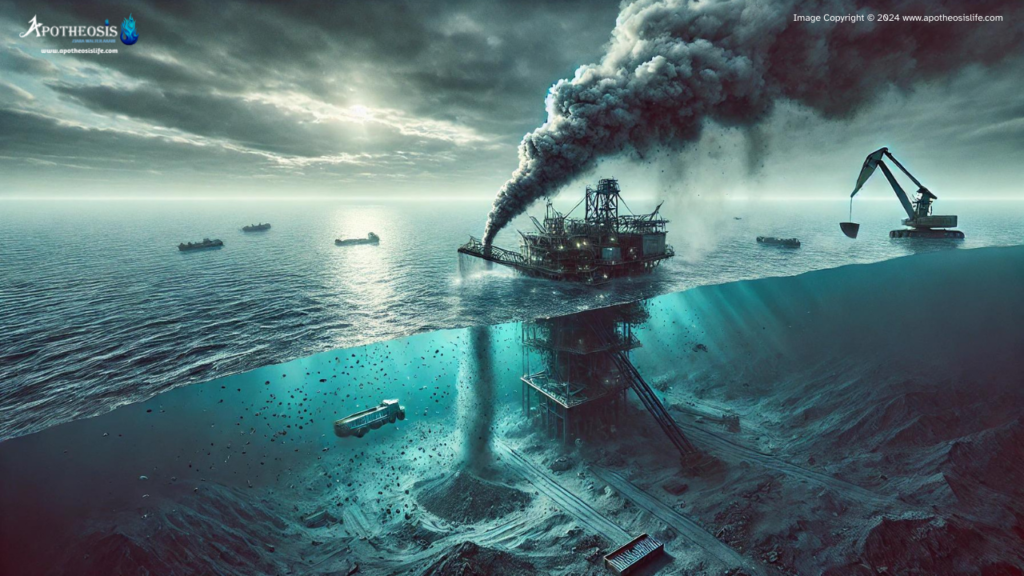Deep sea mining is an emerging industry that involves extracting minerals and metals from the ocean floor. As land-based resources become increasingly scarce, deep sea mining offers the potential to access valuable materials needed for modern technology and renewable energy systems. However, this new frontier also raises significant environmental and ethical concerns, making it a topic of intense debate among scientists, policymakers, and environmentalists.
What is Deep Sea Mining?
Definition
Deep sea mining refers to the process of retrieving mineral resources from the ocean floor, typically at depths of 200 meters or more. The primary targets for deep sea mining include polymetallic nodules, seafloor massive sulfides, and cobalt-rich ferromanganese crusts. These deposits contain metals such as nickel, copper, cobalt, manganese, and rare earth elements, which are essential for manufacturing batteries, electronics, and renewable energy technologies.
Types of Resources
Polymetallic Nodules: Potato-sized nodules found on the abyssal plains, rich in metals like manganese, nickel, cobalt, and copper.
Seafloor Massive Sulfides: Formed around hydrothermal vents, these deposits contain high concentrations of copper, gold, silver, and zinc.
Cobalt-rich Ferromanganese Crusts: Found on seamounts, these crusts contain valuable metals like cobalt, nickel, and rare earth elements.
The Potential Benefits of Deep Sea Mining
Resource Availability
The demand for metals like cobalt, nickel, and rare earth elements is skyrocketing due to the growth of renewable energy technologies, such as electric vehicles and wind turbines. Deep sea mining offers an alternative to land-based mining, which is often associated with environmental degradation and social conflicts.
Economic Opportunities
Deep sea mining has the potential to create new economic opportunities, particularly for countries with access to mineral-rich areas of the ocean. It could lead to job creation, infrastructure development, and increased revenue from the sale of extracted resources.
Technological Innovation
The challenges associated with deep sea mining have driven advancements in technology, including remotely operated vehicles (ROVs), autonomous underwater vehicles (AUVs), and sophisticated drilling and extraction equipment. These innovations could have broader applications in marine science, underwater exploration, and environmental monitoring.

Image Copyright © 2024 www.apotheosislife.com
Environmental and Ethical Concerns
Habitat Destruction
The deep sea is home to unique and fragile ecosystems that are poorly understood. Mining activities, such as sediment plumes, noise pollution, and physical disturbances, can destroy habitats, disrupt species, and lead to the loss of biodiversity. The long-term ecological impacts of deep sea mining are largely unknown, raising concerns about irreversible damage.
Impact on Marine Life
Deep sea organisms, many of which are endemic and have adapted to extreme conditions, could be severely affected by mining activities. The disruption of seafloor habitats and the release of toxic substances from mining processes could lead to significant declines in marine populations, including species that have yet to be discovered.
Carbon Sequestration
The deep sea plays a critical role in carbon sequestration, with sediments and organisms helping to store vast amounts of carbon dioxide. Disturbing these ecosystems could release stored carbon back into the atmosphere, exacerbating climate change.
Regulatory and Governance Challenges
The governance of deep sea mining is complex and involves multiple stakeholders, including national governments, international organizations, and private companies. The International Seabed Authority (ISA) is responsible for regulating deep sea mining in international waters, but there are concerns about the effectiveness of existing regulations in protecting the marine environment.
Balancing Benefits and Risks
Sustainable Practices
To mitigate the environmental risks of deep sea mining, it is crucial to develop and implement sustainable practices. This includes conducting thorough environmental impact assessments, establishing no-mining zones to protect sensitive areas, and adopting technologies that minimize habitat destruction.
International Cooperation
Given the global nature of the oceans, international cooperation is essential for managing deep sea mining. Countries must work together to establish robust regulatory frameworks, share scientific knowledge, and ensure that mining activities do not compromise the health of marine ecosystems.
Alternative Solutions
Exploring alternatives to deep sea mining, such as recycling existing materials, developing more efficient technologies, and reducing the demand for certain metals, could help alleviate the pressure on deep sea resources. Investing in research to better understand deep sea ecosystems and their role in the global environment is also critical.
Deep sea mining represents a new frontier with the potential to provide valuable resources for modern technology and economic development. However, it also poses significant environmental and ethical challenges that must be carefully considered. Balancing the benefits of deep sea mining with the need to protect fragile marine ecosystems requires a cautious and informed approach, guided by scientific research, international cooperation, and a commitment to sustainability.
Details of the Featured Image
The image depicts an underwater scene with deep sea mining operations, including remotely operated vehicles (ROVs) and large machinery on the ocean floor. The dark, mysterious backdrop of the deep sea, combined with sediment plumes, highlights the industrial and environmental impact of the operations. The use of dark blues and metallic colors emphasizes the scale and seriousness of deep sea mining activities.
Image Copyright © 2024 www.apotheosislife.com
Author
Ziara Walter Akari
© www.apotheosislife.com
